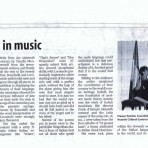AMMAN – Music and language going hand-in-hand, few languages can do it as well as Italian.
With very lively music and a pleasantly varied programme, pianist Patrizia Scascitelli and vocalist Emiliano Loconsolo entertained an audience of connoisseurs on Saturday night at Al Hussein Cultural Centre in Amman (Jordan). The two artists performed pieces that spanned nearly one millennium of Italian music and that were meant to illustrate the unique musicality of their language, a trait that no one would even think of denying today, if only for the enchanting bel canto and the magnificent operas that Italy gave to the world.
From “Jesce Sole/Muccatora” that was presented as the oldest known Italian song, dating back to the eleventh century, to just-written, “freshly baked” in Loconsolo’s own words, modern compositions by Scascitelli herself, the performance of the two Italian artists was a perfectly convincing demonstration of the concert’s main theme: the musicality of their beautiful language.
Moving then to songs by Giovan Domenico da Nola from the sixteenth century, by Claudio Monteverdi from the seventeenth century, and finally all the way to the twenty first, Scascitelli and Loconsolo sailed with ease and grace through all pieces. In addition to displaying the beauty of their language, the musicians showed the obvious influence of jazz on their style. For even in songs from centuries past, the pianistic arrangements by Scascitelli and the vocal interpretation of Loconsolo were strongly jazz-flavoured.
The duo ended the concert with a witty finale where Italian evergreens like “Volare”, “That’s Amore” and “Non Dimenticar” were elegantly mixed. Both artists showed exceptional skills, with Loconsolo particularly impressive when starting some of the songs solo and with a perfect pitch, without the help of the piano giving him the note that most singers need to start. It’s just too bad that the sound system was not good as it should have been and did not do full justice to the voice of the singer and to his talent.
Several of the poems put in music were in the particular Neapolitan dialect, a form of Italian that not all those who speak the main language could understand, but that nevertheless is a delicious flavor of it. Another proof that it is the sound that counts.
Talking to the audience, the artists mentioned the contribution of their country to the world’s music heritage. Indeed, the very foundation of modern music theory, mainly, was the work of Italian musicians like theorist Guido d’Arezzo (eleventh century) and the Latin names of the notes (do, re, mi …) were taken from the first syllable of “Ut queant laxis”, a hymn attributed to Italian monk Diaconus.
The event took place with the eleventh week of the Italian language in the world, and on the occasion of the 150th anniversary of Italian Unity. It was presented by the Italian embassy in Jordan and the Dante Alighieri Society.
– Jean-Claude Elias, The Jordan Times (Jordan), October 24, 2011

